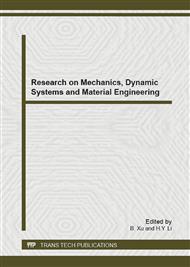[1]
Faltinsen O.M., Landrini M., Greco M., Slamming in marine applications, Journal of Engineering Mathematics, Vol. 48, 2004, pp.187-217.
DOI: 10.1023/b:engi.0000018188.68304.ae
Google Scholar
[2]
Tutt B.A., Taylor A.P., The use of LS-DYNA to simulate the water landing characteristics of space vehicles, 8th international LS-DYNA users conference, 2004, Detroit.
DOI: 10.2514/6.2005-1608
Google Scholar
[3]
R.A. Gingold and J.J. Monaghan. Smoothed particle hydrodynamic: theory and application to non-spherical stars. Monthly Notice Roy Astronom Society 181, pp.375-390, (1977).
DOI: 10.1093/mnras/181.3.375
Google Scholar
[4]
J. Bonet and S. Kulasegaram. Correction and stabilization of smooth particle hydrodynamics methods with applications in metal forming simulations, International Journal for Numerical Methods in Engineering 47, 1189-1214, (2000).
DOI: 10.1002/(sici)1097-0207(20000228)47:6<1189::aid-nme830>3.0.co;2-i
Google Scholar
[5]
D.F. Medina and J.K. Chen. Three-dimensional simulations of impact induced damage in composite structures using the parallelized SPH method, Composites Part A (Applied Science and Manufacturing), 31A 853-860, (2000).
DOI: 10.1016/s1359-835x(00)00031-2
Google Scholar
[6]
A. Souto Iglesias, L. Pérez Rojas and R. Zamora Rodríguez. Simulation of anti-roll tanks and sloshing type problems with smoothed particle hydrodynamics, Ocean Engineering, 31(8-9), 1169-1192, (2004).
DOI: 10.1016/j.oceaneng.2003.09.002
Google Scholar
[7]
J.L. Lacome. Smoothed Particle Hydrodynamics (SPH): a new feature in LS-DYNA. In 7th International LS-DYNA Users Conference, (2002).
Google Scholar
[8]
J. O Hallquist. LS-DYNA Theoretical Manual,. Livermore Software Technology Corporation, Livermore, (2006).
Google Scholar
[9]
J. O Hallquist. Keyword User's Manual,. Livermore Software Technology Corporation, Livermore, (2007).
Google Scholar
[10]
J. O Hallquist. LS-PrePost Manual, Version 1. 0. Livermore Software Technology Corporation, Livermore, (2002).
Google Scholar
[11]
Laverty S.M., Experimental hydrodynamics of spherical projectiles impacting on a free surface using high speed imaging techniques, MS Dissertation, Massachusetts Institute of Technology, (2004).
Google Scholar
[12]
Von Kármán. The impact of seaplane floats during landing. NACA Technical Note 321, (1929).
Google Scholar
[13]
Miloh T., On the Initial-stage slamming of a rigid sphere in a vertical water entry, Applied Ocean Research, Vol. 13, 1991, pp.43-48.
DOI: 10.1016/s0141-1187(05)80039-2
Google Scholar
[14]
Wagner, H., Über Stoss und Gleitvorgange an der ober-flacke von flüssigkeiten. Zeitschr. f. Angew. Math. undMech. , Vol. 12, No. 4, p.193–235 (In German), (1932).
Google Scholar


